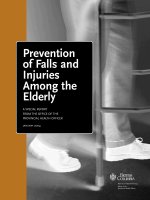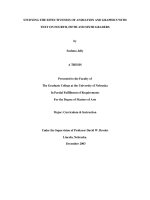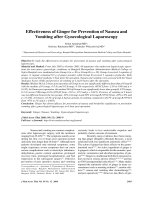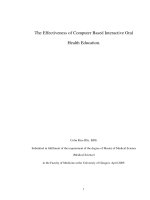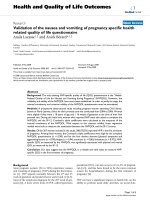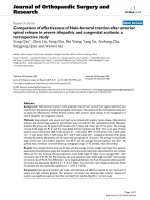Effectiveness of Ginger for Prevention of Nausea and Vomiting after Gynecological Laparoscopy docx
Bạn đang xem bản rút gọn của tài liệu. Xem và tải ngay bản đầy đủ của tài liệu tại đây (77.3 KB, 7 trang )
J Med Assoc Thai Vol. 89 No. 12 2006 2003
Effectiveness of Ginger for Prevention of Nausea and
Vomiting after Gynecological Laparoscopy
Sirirat Apariman MD*,
Sawinee Ratchanon MD*, Budsaba Wiriyasirivej MD*
* Department of Obstetrics and Gynecology, Bangkok Metropolitan Administration Medical College and Vajira Hospital
Objective:To study the effectiveness of ginger for prevention of nausea and vomiting after gynecological
laparoscopy.
Material and Method: From July 2005 to October 2005, 60 inpatients who underwent laparoscopic opera-
tions for non-cancer gynecologic conditions at Bangkok Metropolitan Administration Medical College or
Vajira Hospital were randomized into Group A (n = 30) or Group B (n = 30). Group A received 3 capsules of
ginger (1 capsule contained 0.5 g of ginger powder) while Group B received 3 capsules of placebo. Both
groups received their medicine 1 hour prior the operation. Nausea and vomiting were assessed with the Visual
Analogue Scores (VAS) and presence of vomiting at 2 and 6 hours after the operation.
Results: Median VAS at 2 hours post operation of Group A was not significantly different from that of Group B
with the median of 0 (range, 0-5.4) and 0.15(range, 0-10) respectively (95%CI from -2.59 to 0.90 and p =
0.142). At 6 hours post operation, the median VAS of Group A was significantly lower than group B, 0.55(range,
0-7.4) versus 2.80(range,0-10) (95%CI from -3.61 to -0.73 and p = 0.015). Presence of vomiting at 2 hours
was not different between the two groups, 10% in Group A and 20% in Group B (95%CI from -28% to 8% and
p = 0.278). At 6 hours, 23.3% of group A had an episode of vomiting compared to 46.7% of group B (95%CI
from -47% to 1% and p = 0.058).
Conclusion: Ginger has shown efficacy for prevention of nausea and borderline significance to prevention
vomiting after gynecological laparoscopy at 6 hour post operation.
Keywords: Ginger, Nausea, Vomiting, Gynecological laparoscopy
Nausea and vomiting are common complica-
tions after laparoscopic surgery with the incidence
ranging from 25-40%
(1-3)
. The symptoms usually occur
during the first 4 to 6 hours post operation period
and rarely lasts longer than 24 hours
(4)
. Although most
patients developed only minimal symptoms, some
might experience severe symptoms that can cause
serious complications such as electrolyte imbalance,
dehydration, gastric content aspiration, prolonged
recovery time, prolonged hospitalization, and bad
impression to the subsequent surgery
(5)
. Effective
prevention of post operative nausea and vomiting
certainly leads to less undesirable sequelae and
probably a better outcome of treatment.
Recently, many evidences have been emerg-
ing that ginger (Zingiber officinale Roscoe), a local
medicinal herb, has significant antiemetic effect
(3,6-8)
.
The action of ginger has direct effects on the gastro-
intestinal tract
(9-11)
. An active ingredient of ginger is
6-gingerol, which is responsible for the aromatic, spas-
molytic, carminative and absorbent properties of gin-
ger
(9,10)
. Ginger is a traditional herb that is inexpensive,
does not have serious adverse effects
(9,10,12-16)
and has
no CNS (extrapyramidal) side effects
(9-11)
. Many studies
reported the antiemetic effect of ginger in many cir-
cumstances such as morning sickness
(17)
, motion sick-
ness
(18)
, nausea and vomiting after chemotherapy
(19)
,
and post operatively
(3,6-8)
. However, the effects of gin-
Correspondence to : Apariman S, Department of Obstetrics
and Gynecology, Bangkok Metropolitan Administration
Medical College and Vajira Hospital, 681 Samsen Rd, Dusit,
Bangkok 10330, Thailand. Phone: 0-1682-6002
J Med Assoc Thai 2006; 89 (12): 2003-9
Full text. e-Journal: />2004 J Med Assoc Thai Vol. 89 No. 12 2006
ger in cases of postoperative gynecological laparo-
scopy are controversial. A dose of 1 gm has been used
in a previous study. Some studies showed effective-
ness of ginger 1 gm in outpatient gynecological
laparoscopy cases
(3,8)
, however other studies reported
negative results
(20-22)
. Therefore, the objective of the
present study was to study the effectiveness of ginger
in a larger dose (1.5 gm) for prevention of nausea and
vomiting after gynecological laparoscopy.
Material and Method
From July 2005 to October 2005, 60 patients
who were admitted for elective non-cancer gyneco-
logical laparoscopy were included in the present study.
The present study was conducted after approval from
the Ethics Committee of the institution. All patients
gave their written informed consent before entering
the present study. The patients were included if they
could speak and read Thai and were able to swallow
drug capsules. The patients were excluded if their ages
were below 18, pregnant, had underlying gastrointesti-
nal or hepatic diseases, received antiemetic drug or
any medications that might have side effects of nausea
or vomiting within 24 hours before surgery, or had a
history of ginger allergy. Patients who would undergo
laparoscopic hysterectomy were also excluded. All
patients included in the present study were randomized
by blocks of four into Group A (n = 30) or Group B (n =
30). Group A received ginger 1.5 gm (three capsules of
0.5 gm ginger powder); Group B received three capsules
of placebo that looked the same as the ginger capsule.
Patients were instructed to score their nausea symp-
tom according to the Visual Analogue nausea Score
(VAS), and they were assessed for vomiting, a side
effect of the drug, by a physician at 2 and 6 hours after
surgery. Nausea is defined as discomfort symptom at
pharyngeal or upper gastric area that might lead to
vomiting, and was subjective
(5)
. VAS of nausea was
recorded on a 10 cm linear analogue scale that ranged
from 0 (no nausea at all) to 10 (the worst nausea). Vomit-
ing is defined as severe gastrointestinal motility that
caused a projection of gastrointestinal content from
the oral route
(5)
. Presence of vomiting was regarded
when gastric content was present.
Ginger or placebo capsules were swallowed
with 30 ml water at 1 hour before starting the operation.
Similar anesthetic technique and agents were provided
in both groups. Intraperitoneal CO
2
pressure was con-
trolled at 15 mmHg and was released when the opera-
tion was finished. Intraoperative use of opioid was
administered upon the anesthesiologist’s decision.
Post operative analgesic was given upon the patient’s
requirement. Antiemetic drug (Metoclopramide) was
given when more than 2 episodes of vomiting occurred.
Data recorded included: age, body weight,
occupation, drug allergic history, prior intake medica-
tion within 24 hours preoperation, past history of ill-
ness, history of post operative nausea vomiting, type
and duration of surgery, the use of opioid during sur-
gery, the requirements of postoperative analgesia and
antiemetic drug. The VAS, episode of vomiting and
side effect of ginger such as itching, abdominal pain,
heartburn, respiratory discomfort, insomnia were also
recorded at 2 and 6 hours post operation.
Data were analyzed using SPSS statistical
software version 11.5 (SPSS, Chicago, IL). Descriptive
statistics were used for demographic data and summa-
rized as mean with Standard Deviation (SD), median
with range, or frequency with percentage. The Mann-
Whitney U test was used to compare continuous vari-
able. The Chi- square test was used to compare catego-
rical data between the two groups. The outcomes were
significant if p < 0.05.
Results
Sixty patients were included in the present
study. Demographic data were similar in both groups
in terms of age, weight, occupation, past history of
illness, history of post operative nausea vomiting, type
and duration of surgery. The use of opioid during sur-
gery and post operative periods (within 2 hour and at
2-6 hours) revealed no statistical significant difference
between both groups (Table 1).
At 2 hours post operation, median VAS in the
ginger group was 0 (range, 0-5.4) and in the placebo
group it was 0.15 (range, 0-10) (Table2). Vomiting was
found in 10% of the ginger group and 20% in the pla-
cebo group (Table 3). There were no statistical signifi-
cant differences in both nausea (p = 0.142, 95%CI from
-2.59 to 0.90) and vomiting (p = 0.278, 95%CI from -28%
to 8%).
At 6 hours postoperatively, median VAS 0.55
(range, 0-7.4) in the ginger group was lower than in the
placebo group 2.80 (range, 0-10) (p = 0.015, 95%CI from
-3.61 to -0.73). Incidence of vomiting was also lower
in the ginger group (23.3%) compared to that in the
placebo group (46.7%) (p = 0.058, 95%CI from -47% to
1%).
Since the VAS at 6 hours post operation
might be affected by the use of opioid within the 2 hour
post operation, the authors factored the result accord-
ing to the use of opioid. The opioid use was approxi-
J Med Assoc Thai Vol. 89 No. 12 2006 2005
mated half in both groups (43.4% and 53.3%). So, this
created subgroup VAS and they were analyzed at 6 hr
post operation between the pethidine
received group
and no pethidine
received group. In the pethidine
received group, median VAS was 1.30(range, 0-4.50) in
the ginger group and was lower in the placebo group
5.70 (range, 0-10.0) (p = 0.036, 95%CI from -3.83 to -
0.86). But in the no pethidine
received group, the VAS
of either groups were not significantly different, 0
(range, 0-7.4) and 0.3 (0-7.3) (p = 0.432, 95%CI from -
2.64 to 1.05).
Side effects such as abdominal discomfort,
heartburn, flu-like symptoms and insomnia found at 2
hours and 6 hours post operation in the ginger group
were at 16.7% and 6.7% compared to 23.3% and 13.3%
in the placebo group. There were no significant dif-
ferences in either group (p = 0.519, 95%CI from -6.77%
to 5.44%), (p = 0.671, 95%CI from -4.60% to 3.26%).
Table 1. The demographic baseline characteristics as shown in mean (SD), median (range) and number (%)
Data Ginger group Placebo group
(n = 30) (%) (n = 30) (%)
Age (years)
Mean + SD 34.37+5.86 34.93+7.15
Weight (kg)
Mean + SD 51.63+6.23 55.30+9.16
Occupation
Government official 6 (20.0) 5 (16.7)
Company official 11 (36.7) 14 (46.7)
Trader, housewife, employee 13 (43.3) 11 (36.6)
Past illness history
No 24 (80.0) 25 (83.3)
Yes* 6 (20.0) 5 (16.7)
Postoperative nausea vomiting history
No 28 (93.3) 27 (90.0)
Yes 2 (6.7) 3 (10.0)
Type of laparoscopic surgery
Diagnosis and lysis adhesion 11 (36.7) 11 (36.7)
Salpingectomy 1 (3.3) 1 (3.3)
Cystectomy 12 (40.0) 14 (46.7)
Myomectomy 6 (20.0) 4 (13.3)
Duration of surgery (minutes)
Median (range) 137.5 (60-300) 145 (55-270)
Analgesics useIntraoperative
No 1 (3.3) 1 (3.3)
Morphine 3-10 mg 11 (36.7) 12 (40.0)
Fentanyl 50-100 g 18 (60.0) 17 (56.7)
Postoperative within 0-2 hour
No 16 (53.3) 11 (36.7)
Pethidine
13 (43.4) 16 (53.3)
Other** 1 (3.3) 3 (10.0)
Postoperative 2-6 hour
No 25 (83.3) 26 (86.6)
Pethidine
5 (16.7) 2 (6.7)
Other** 0 (0.0) 2 (6.7)
* Hypertension, thyroid, major depression, migraine, allergic rhinitis, thalassemia, herniated disc
** Tramol
, Diclofenac
, Paracetamol
Discussion
Nausea and vomiting are common complica-
tions of laparoscopic surgery. They are caused by pneu-
moperitoneum with subsequent diaphragmatic irrita-
tion
(1,2,4)
and increased arterial carbon dioxide tension
(PaCO2) from abdominal insufflations of CO2 that could
trigger cortical afferent fiber sending impulse to the
2006 J Med Assoc Thai Vol. 89 No. 12 2006
vomiting center. These mechanisms presented clini-
cally as nausea and vomiting
(4,23)
.Multiple predispos-
ing factors associated with postoperative nausea vom-
iting included female gender, obesity, previous history
of postoperative nausea vomiting, anxiety, pain, pro-
longed operative procedure, opioid use, abdominal
surgery and general anesthesia
(5,24,25)
.
In the present study, there were no differences
among both groups with respect of the patient’s demo-
graphics data, type of operation, anesthetic process
and opioid use during operation.
Ginger has an action to increase gastric moti-
lity, absorption neutralizing toxins and acids, and block
gastrointestinal reactions and subsequent nausea
feedback
(7)
. The aromatic and carminative properties
of ginger suggest an action on the gastrointestinal
tract
(9-11,26)
without CNS effect
(3,7,27)
. Although ginger
has long been recognized for its antiemetic effect, the
optimal dose has not been established
(3,9,10)
.
The present study used ginger 1.5 grams.
This was found to be safe and without toxic side effect.
The authors found that VAS at 2 and 6 hours post
operation in the ginger group were lower than that in
the placebo group. However, the difference proved
significant only at 6 hour post operation (p = 0.015,
95%CI from -3.61 to -0.73). In addition, the present
study showed that VAS at 2 hours post operatively
was lower than 6 hours postoperation in both groups.
The underlying reasons were:
1) Pain and mobilization when the patient
was moved from the recovery room to the ward after 2
hours post operation could trigger the nausea vomit-
ing mechanism.
2) Analgesic use, e.g. pethidine
, at post
operative 2 hours caused nausea vomiting side effect
within 4 hours after administration. There were un-
avoidable and ethical reasons to giving potent post
operative analgesia to patient.
Table 2. VAS at 2 and 6 hour postoperation of both groups
Median VAS (range)
Postoperative time Difference (95%CI) p-value
Ginger group Placebo group
2 hour 0 (0-5.40) 0.15 (0-10) -2.59, 0.90 0.142
6 hour 0.55 (0-7.40) 2.80 (0-10) -3.61, -0.73 0.015
Table 4. Subgroup analysis of VAS at 6 hour postoperation
Median VAS at 6 hour (range)
Group Difference (95%CI) p-value
Ginger group Placebo group
Pethidine
1.30 (0-4.50) 5.70 (0-10) -3.83, -0.86 0.036
No Pethidine
0 (0-7.40) 0.30 (0-7.3) -2.64, 1.05 0.432
Table 3. Presences of vomiting at 2 and 6 hour postoperation
Group
Presence of vomiting Difference (95%CI) p-value
Ginger Placebo
n = 30 (%) n = 30 (%)
Postoperative 0-2 hour
No 27 (90.0%) 24 (80.0%)
Yes 3 (10.0%) 6 (20.0%) -28%, 8% 0.278
Postoperative 2-6 hour
No 23 (76.7%) 16 (53.3%)
Yes 7 (23.3%) 14 (46.7%) -47%, 1% 0.058
J Med Assoc Thai Vol. 89 No. 12 2006 2007
The VAS of pethidine
received group and
no pethidine
received group at 6 hour post operation
were compared. There was no significant difference of
VAS between the ginger and placebo groups. But in
the pethidine
received group, there was significant
lower VAS in the ginger group compared to placebo
(p = 0.036, 95%CI from -3.83 to -0.86). Interestingly,
the authors also found that ginger was effective in
reducing nausea side effects from the unavoidable
opioid for severe postoperative pain.
The incidences of vomiting at 2 and 6 hours
post operation in the ginger group were lower than
that in the placebo group however, at 6 hours post
operation, it was borderline significant (p = 0.058,
95%CI from -47% to 1%).
The authors concluded that ginger was effi-
cacious in preventing nausea rather than vomiting at
6 hours post operation. The limitation of the present
study may be the small sample size for detecting the
difference of antiemetic effect, against vomiting, which
occurred with a lower incidence.
Other studies also reported efficacy of
ginger in prevention nausea and vomiting. Phillip et
al
(3)
found that ginger was effective in preventing post
operative nausea and vomiting. Despite lower ginger
powder use of 1 gm. and much shorter duration of
surgery (diagnostic laparoscopy), the result was com-
patible with the present study that the incidence of
post operative nausea vomiting in the ginger group
was lower than the placebo group. In the same way,
Pongrojpaw et al
(8)
reported that ginger significantly
reduced the incidence of post operative nausea vomit-
ing at 2 and 4 hours, in some laparoscopic procedures
(laparoscopic tubal sterilization, laparoscopic diagno-
sis, and laparoscopic cystectomy), with a shorter dura-
tion of operation and post operative analgesic used
that was not clearly defined.
In contrast, Arfeen et al
(20)
and Visalyaputra
et al
(21)
reported negative results of ginger. This was
probably due to timing of assessment as it was only a
single evaluation at post operation. Furthermore, the
patient’s ability to communicate after anesthesia was
limited. Leopold et al
(22)
reported that ginger was in-
effective however, the study gave a low dose of ginger
that probably did not reach the therapeutic level.
As a general principle, the side effect from
any drug usage should be an important consideration.
Ginger had no severe side effects in any of the authors’
treatment and is similar to previous studies
(3,7,8)
. Some
side effects including abdominal discomfort, heartburn
and flu-like symptom were presented in some of the
presented cases. That might be caused by the hot,
spice and gastrointestinal irritation effect of ginger.
Insomnia appeared in some patients and was most
likely the effect of opioid.
The route of ginger usage is limited with no
parenteral administration. Oral form of ginger as pre-
medication may be the problem of anesthetic process.
Capsule preparation may protect gastrointestinal
irritation but it is difficult to swallow especially if pre-
operative fluid intake is limited. The other consider-
ation is that ginger is an herbal medicine, so there is no
definite quality control of the preparation.
Conclusion
Ginger is effective for the prevention of nau-
sea and borderline significance to prevent vomiting
after gynecological laparoscopy with no significant
side effect. Moreover, antiemetic effect on post opera-
tive opioid use for severe pain was surprisingly signifi-
cant. However, the present study compared only a small
number of patients and in limited indication of post
operative laparoscopic surgery. For further study, the
authors need a larger number of patients and more
indications are warranted.
References
1. Nzoghe NP, Ogowet IN, Pither S, Ngaka ND. Am-
bulatory laparoscopic gynecological surgery in
African: feasibility. Eur J Gynecol Obstet Biol
Reprod 2001; 30: 462-6.
2. Hedayati B, Fear S. Hospital admission after day
case gynaecological laparoscopy. Br J Anaesth
1999; 83: 776-9.
3. Phillips S, Ruggier R, Hutchinson SE. Zingiber
officinale (ginger) and antiemetic for day case sur-
gery. Anaesthesia 1993; 48: 715-7.
4. Borten M. Postoperative complications. In: Fried-
man EA, editor. Laparoscopic complications. 1
st
ed. Kowloon: Holt-Saunders; 1986: 406-14.
5. Nakata DA, Stoelting RK. Postoperative nausea
and vomiting. In: Atlee JL, editor. Complications in
anesthesia. 1
st
ed. Philadelphia: WB Saunders
Company; 1999: 195-8.
6. Ernst E, Pittler MH. Efficacy of ginger for nausea
and vomiting: a systematic review of randomized
clinical trials. Br J Anaesth 2000; 84: 367-71.
7. Bone ME, Wilkinson DJ, Young JR, Mcneil J,
Charlton S. Ginger root-a new antiemetic: the ef-
fect of ginger root on postoperative nausea and
vomiting after major gynecological surgery.
Anaesthesia 1990; 45: 669-71.
2008 J Med Assoc Thai Vol. 89 No. 12 2006
8. Pongrojpaw D, Chiamchanya C. The efficacy of
ginger in prevention of post-operative nausea
and vomiting after outpatient gynecological
laparoscopy. J Med Assoc Thai 2003; 86: 244-50.
9. World HealthOrganization. Hizoma Zingerbiris
Monograph. In: WHO, editor. Monographs on
selected medicinal plants. 1
st
ed. Geneva: World
Health Organization, 1999: 277-87.
10. Tyler VE. Herbal medicine. Newton: Laulanes’
Publishers; 2002: 78-83.
11. Holtmann S, Clarke AH, Scherer H, John M. The
anti-motion sickness mechanism of ginger: a com-
parative study with placebo and dimenhydrinate.
Acta Otolaryngol (Stockh) 1989; 108: 168-74.
12. Verma SK, Singh J, Khamesra R,Bordia A. Effect of
ginger on platelet aggregation in man. Indian J
Med Res 1993; 98: 240-2.
13. Janssen PL, Meyboom S, Vanstaveren WA, Devegt
F, Katan MB. Consumption of ginger (Zingiber
officinale roscoe) dose not affect in vivo platelet
thromboxane production in humans. Eur J Clin Nutr
1996; 50: 772-4.
14. Lumb A. Effect of dried ginger on human platelet
function. Thromb Haemost 1994; 71: 110-1.
15. Srivastava KC. Aqueous extracts of onion, garlic
and ginger inhibit platelet aggregation and after
arachidonic acid metabolism. Biomed Biochim Acta
1984; 43: 335-46.
16. Backon J. Ginger in preventing nausea and vomit-
ing of pregnancy: a caveat due to its thromboxane
synthetase activity and effect on testosterone
binding. Eur J Obstet Gynecol Reprod Biol 1991;
42: 163-4.
17. Grontved A, Brask T, Kambskard J, Hentzer E. Gin-
ger root against sea sickness: a controlled trial on
open sea. Acta Otolaryngol 1988; 105: 45-9.
18. Fischer-Rasmussen W, Kjaer SK, Dahl C, Asping
U. Ginger treatment of hyperemesis gravidarum.
Eur J Obstet Gynecol Reprod Biol 1990; 38: 19-24.
19. Pace JC. Oral ingestion of encapsulated ginger and
reported self-care actions for the relief of chemo-
therapy - associated nausea and vomiting. Disser-
tations Abstracts Int 1987; 47: 3297-B.
20. Arfeen Z, Owen H, Plummer JL, Ilsley AH, Sorby-
Adams RA, Doecke CJ. A double-blind randomized
controlled trial of ginger for the prevention of
postoperative nausea and vomiting. Anaesth
Intensive Care 1995; 23: 449- 52.
21. Visalyaputra S, Petchpaisit N, Somcharoen K,
Choavaratana R. The efficacy of ginger root in the
prevention of postoperative nausea and vomiting
after outpatient gynaecological laparoscopy.
Anaesthesia 1998; 53: 506-10.
22. Leopold HE, Roswitha M, Oliver B, Stergios T, Wolf-
gang H, Astrid MM, et al. Ginger does not prevent
postoperative nausea and vomiting after laparo-
scopic surgery. Anaesth Analg 2003; 96: 995-8.
23. Palazzo MGA, Strunin L. Anesthesia and emesis
II: prevention and management. Canadian Anaesth
Soc 1984; 31: 407-15.
24. Korttila K. The study of postoperative nausea and
vomiting. Br J Anaesth 1992; 69: 20.
25. Palazzo MGA, Strunin L. Anesthesia and emesis I:
etiology. Canadian Anaesth Soc 1984; 31: 178-87.
26. Tyler VE, Foster S. Herbs and ytomedicinal pro-
duct. In: Covington TR, Beradi RR, Young LL,
editors. Handbook of subscription drugs. 11
th
ed.
Washington DC: American Pharmaceutical Asso-
ciation; 1996: 697.
27. Holtmann S, Clarke AH, Scherer H, Hohn M. The
antimotion sickness mechanism of ginger. Acta
Otolaryngol 1989; 108: 168-74.
J Med Assoc Thai Vol. 89 No. 12 2006 2009
ประสิทธิผลของขิงในการป้องกันภาวะคลื่นไส้อาเจียนภายหลังการผ่าตัดผ่านกล้องทางนรีเวช
สิริรัตน์ อปริมาณ, สาวินี รัชชานนท์, บุษบา วิริยะสิริเวช
วัตถุประสงค์: ศึกษาประสิทธิผลของขิงในการป้องกันภาวะคลื่นไส้อาเจียนภายหลังการผ่าตัดผ่านกล้องทางนรีเวช
วัสดุและวิธีการ: ทำการศึกษาตั้งแต่เดือนกรกฎาคม พ.ศ. 2548 ถึงเดือนตุลาคม พ.ศ. 2548 มี จำนวนผู้ป่วย 60 ราย
โดยเป็นผู้ป่วยในที่ไม่มีโรคทางมะเร็งนรีเวชและเข้ารับการผ่าตัดผ่านกล้อง ณ วิทยาลัยแพทยศาสตร์ กรุงเทพมหานคร
และวชิรพยาบาล ทำการสุ่มแบ่งเป็น 2 กลุ่ม กลุ่มละ 30 ราย กลุ่มแรกได้รับขิง 3 แคปซูล (1 แคปซูลบรรจุขิงผงขนาด
0.5 กรัม) กลุ่มที่สองได้รับยาหลอกจำนวน 3 แคปซูล รับประทานก่อนเข้ารับการผ่าตัด 1 ชั่วโมงเช่นเดียวกันทั้งสองกลุ่ม
ทำการประเมินภาวะคลื่นไส้อาเจียนโดยใช้ระดับคะแนนความคลื่นไส้ (visual analogue score) และอุบัติการณ์ของ
การอาเจียนหลังผ่าตัดที่ 2 และ 6 ชั่วโมง
ผลการศึกษา: ค่าคะแนนความคลื่นไส้ที่ 2 ชั่วโมงหลังผ่าตัดของกลุ่มขิง ไม่มีความแตกต่างอย่างมีนัยสำคัญ เมื่อ
เทียบกับยาหลอก โดยมีคะแนนเฉลี่ย 0 (0-5.4) และ 0.15 (0-10) ตามลำดับ (p = 0.142, 95%CI อยู่ระหว่าง -2.59
ถึง 0.90) ส่วนที่ 6 ชั่วโมงหลังผ่าตัด ค่าคะแนนความคลื่นไส้ในกลุ่มขิงต่ำกว่ากลุ่มยาหลอกอย่างมีนัยสำคัญ มีคะแนน
เท่ากับ 0.55 (0-7.4) และ 2.80 (0-10) (p = 0.015, 95%CI อยู่ระหว่าง -3.61 ถึง -0.73) อุบัติการณ์ของการอาเจียนที่
2 ชั่วโมงหลังผ่าตัดไม่มีความแตกต่างกันทั้งสองกลุ่ม โดยพบ 10% ในกลุ่มขิง และ 20% ในกลุ่มยาหลอก (p = 0.278,
95%CI อยู่ระหว่าง -28% ถึง 8%) แต่ที่ 6 ชั่วโมงหลังผ่าตัดมีความแตกต่างระหว่างสองกลุ่มแบบไม่ชัดเจน พบการ
อาเจียน 23.3% ในกลุ่มขิงเทียบกับ 46.7% ในกลุ่มยาหลอก (p = 0.058, 95%CI อยู่ระหว่าง -47% ถึง 1%)
สรุป: ขิงมีประสิทธิผลในการป้องกันภาวะคลื่นไส้และมีแนวโน้มในการป้องกันการอาเจียนภายหลังการผ่าตัดผ่านกล้อง
ทางนรีเวชที่ชั่วโมงที่ 6 หลังการผ่าตัด



